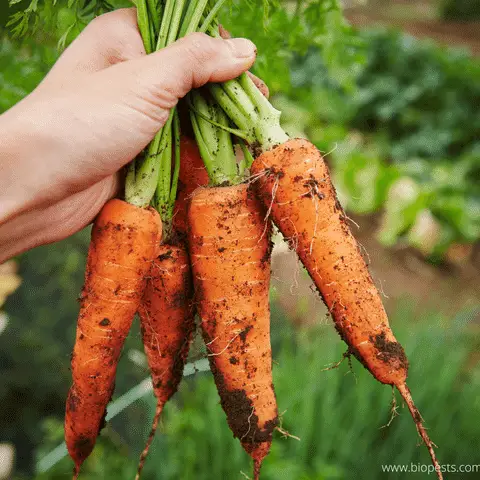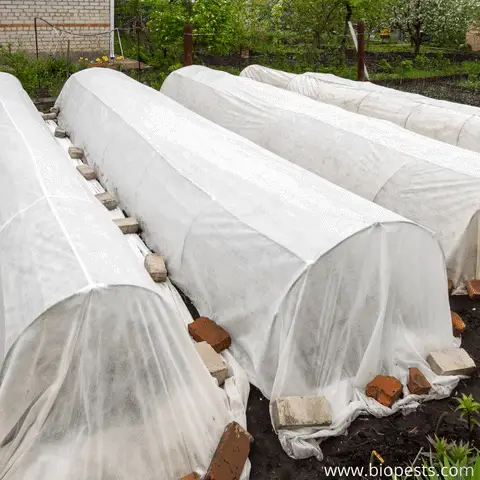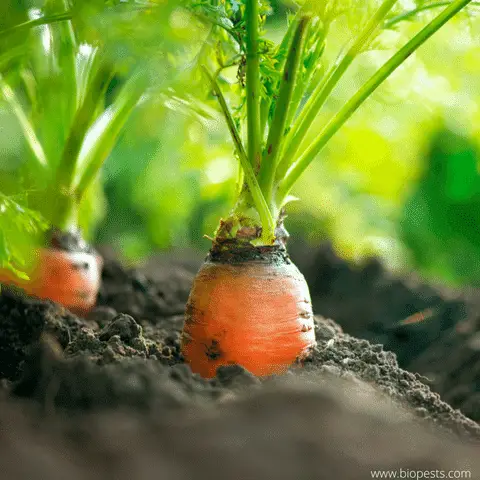Carrots are a relatively easy garden crop to grow, and it is one of the first root vegetables that beginner gardeners try out. If you have grown a crop of carrots and notice holes in the root, you may be concerned about what made these holes and if they have rendered the carrots unusable.
The most likely cause of holes in carrots is a carrot fly infestation in your garden. The flies lay their eggs around the carrot plant, and when the larvae hatch, they burrow into the soil and into the carrot root, eating as they go. Crop rotation and physical protection are the best remedies.
You may think that your carrots are protected under the soil surface, only to be surprised to see something has attacked your carrots, leaving little holes in the roots. The culprit may not be what you think it is, and we have some ideas on what you can do about it!
What Causes Holes in Carrots?
Gardening and growing your own vegetables can be rewarding, but it can also become frustrating when unwelcome visitors to your garden damage your hard work!
Since carrots grow under the soil’s surface, it is difficult to notice holes in your carrots until you come to harvest them and notice the small pinhead-sized holes in your carrot crop.
Slicing the carrot open will reveal that the hole is an entrance to a tunnel in the carrot, which can cause you to think that worms have been invading your carrot patch!
Before you blame the worms and declare an all-out war on them, you should consider that the holes are not made by worms but rather another critter in your garden that is a little more crafty.
Worms, such as earthworms, do not usually snack on developing carrots and cause holes in the root connected to tunnels. Earthworms are unlikely to eat your carrots anyway since they are more interested in the decomposing organic matter rather than fresh carrots.
This is the work of the carrot fly, an insidious pest that is difficult to identify since you usually do not see the culprit in your garden.
Holes In Carrots Caused By Carrot Fly
Many different types of pests could damage the carrots in your garden, but one of the most common culprits is the carrot fly.
The carrot fly sometimes called the carrot rust fly, or scientifically the Chamaepsila rosae, is a common garden pest that often causes problems for carrots in the garden.
These flies lay their eggs on the soil around developing carrot plants or on the crown of the plant. When the carrot fly larvae hatch from the eggs, they burrow into the soil and into the carrot’s root.
The creamy yellow-colored maggots burrow into the carrot root, eating as they go, creating tunnels inside the carrot root.
There is evidence above the ground that this garden pest has attacked your carrots, but you may think the problem is a lack of feeding rather than a pest infestation.

The leaves of the carrot plants infested with these fly larvae can become discolored and appear wilted. The leaves often turn a rusty red and then begin to display yellowing. The larvae do not tunnel deep into the carrot but rather under the skin of the carrot root.
The larvae damage the carrot root, which can lead to secondary problems and diseases, and cause enough damage to render the carrot crop unsuitable for sale at a fresh produce market.
The adult flies do not cause any damage to the carrots; it is only the larvae that damage the carrot roots. The female fly is attracted to the growing carrots by smell, where she promptly lays her eggs on or around the carrot plant.
If the carrot crop is in the early stages of growth, the infestation by the larvae can destroy the carrots completely, decimating the crop and causing total crop failure.
Roots of more mature carrot plants can survive the infestation, but the larger the larvae get, the greater the damage they do to the root. Eventually, the larvae tunnels become large enough that the discoloration is visible under the carrot skin.
When the carrot fly larvae are ready to pupate, they leave the carrot, pupate in the soil, and emerge as adult flies. The larvae are 0.3 inches or 1cm long, making them visible with the eye if you pull out carrots to check for this pest.
Carrot flies are not present everywhere and seem to prefer a temperate climate with mild winters and summers. Most climates with hot summers or very cold winters do not experience this pest on their carrot crops.
Fungal Diseases Caused By Carrot Fly
The damage caused by the carrot fly larvae does not stop at the tunnels it creates in the carrot root. The wounds in the carrot left by the larvae open the carrot to various fungal infections that further damage the root.
If the carrot crop is young, the combined assault of the larvae and the fungi can destroy the entire carrot crop.
One of the most prevalent fungi that could be present in the soil is carrot canker, which can infect the wounds left in the root and cause further damage and discoloration to the carrot root.
How To Prevent Carrot Fly Making Holes In Your Carrots
Once you have a carrot fly infestation, they can be difficult to get rid of unless you take active measures to break their lifecycle.
Gardeners that struggle with the carrot fly are often hit with a double whammy of carrot fly infestation that extends from one season to the next.
The reason for this is the life cycle of the carrot fly. Adult carrot flies overwinter below the soil surface and emerge in the early spring to mate and begin their life cycle. The first generation of carrot fly eggs are laid directly in the soil or on the crown of your new carrot crop.
The second generation damages the carrot roots and then pupates in the soil surrounding the carrot crop. They emerge in July and August and will overwinter in the soil in your vegetable bed.
When you plant your carrots in the soil the following spring, you provide a prime environment for the newly emerging adults to mate and lay eggs directly on and around your new carrot crop.
Use Crop Rotation To Protect Against Carrot Fly
One of the best prevention methods against carrot fly infestations is to break their life cycle by implementing crop rotation in your growing operation. Crop rotation means that you will not grow carrots in the same location that you grew them the year before.
An aspect of crop rotation to bear in mind is that carrot fly larvae do not only eat carrot roots but are also a problem for celery, parsnips, parsley, and celeriac. You should not plant these herbs and vegetables in a bed where you previously planted carrots; they will perpetuate the life cycle of the carrot fly.
If the generation of carrot flies that overwintered in your garden bed soil do not find a ready meal waiting for their larvae in the spring, they may die or fly off to greener pastures in search of a suitable host plant.
For crop rotation to be successful, you should practice a 3 to 5-year rotation and plant your next season’s carrots as far away as possible from the bed that grew your previous season’s carrots.
Use Physical Crop Protection To Prevent Carrot Fly Infestation
Another successful measure to prevent a carrot fly infestation is to take steps to physically protect your carrot plants and prevent the flies from laying their eggs in your garden soil.
The female carrot fly is a low-flying critter that flies below the height of 24-inches or 60cm in search of appropriate plants at ground level.
Creating a net barrier around your carrot bed at least 24-inches or 60cm high, or even better, enclosing the carrot bed with a complete net, will prevent the female flies from accessing the soil near your carrots.
The eggs need to be laid close to the carrots since the larvae cannot move far to find food. This barrier prevents the female from getting close enough to the carrots to lay eggs in their vicinity.
Another barrier method shown to be effective against carrot fly is using row covers or growing fleece. This material is placed over the ground once the carrot seeds have germinated and provide a barrier that the larvae cannot penetrate.

When the row cover is placed over the seedlings, the edges of the material should be buried to prevent the flies from walking under the material to lay their eggs.
Raised beds that are taller than the 24-inch or 60cm mark will be another method of placing your carrot crop out of the danger zone for carrot fly infestation.
Delay Planting To Deter Carrot Fly Infestation
Early season crops are most susceptible to carrot fly infestations because the flies are most active in the early part of spring and typically again in the fall.
Delaying planting carrots until June has shown results in limiting the damage caused by these carrot crop pests.
Companion Planting To Avoid Carrot Fly Invasion
Companion planting or interplanting carrots with other strong-smelling crops is another method of protecting your carrot crop from carrot flies.
Carrot flies find the carrot beds by smell, so if you can mask the smell of the carrots with other strong-smelling crops, you can avoid attracting the flies to your garden.
The best crops to plant with carrots for this purpose are onions, rosemary, marigolds, mint, or garlic.
Conclusion
Carrot flies can be a problem for carrot growing, particularly for carrot crops planted early in the season. Fortunately, the counter-measures of physical barriers, crop rotation, companion planting, or delayed planting can be successful in controlling the carrot fly problem.
If you have carrot flies in your area, you don’t need to stop growing carrots; you just need to outsmart the critters with your gardening methods!
Some of the links above are affiliate links, meaning, at no additional cost to you, I will earn a commission if you click through and make a purchase.

